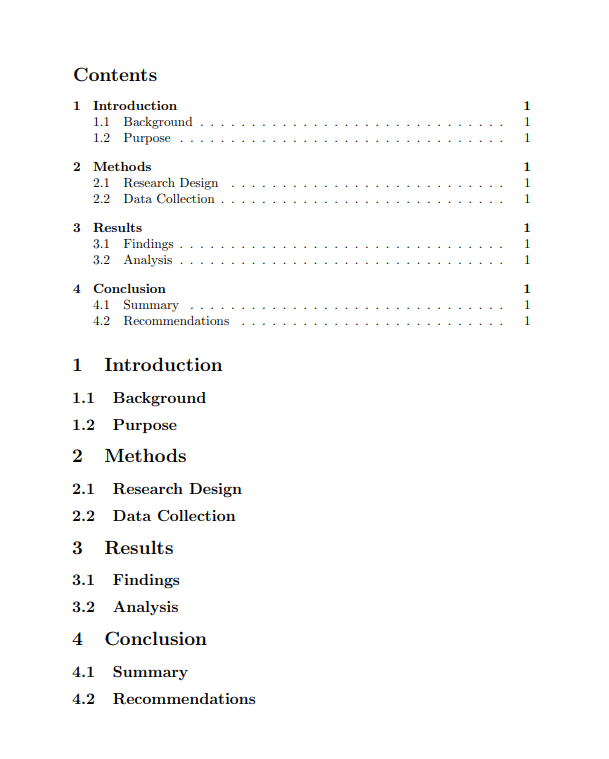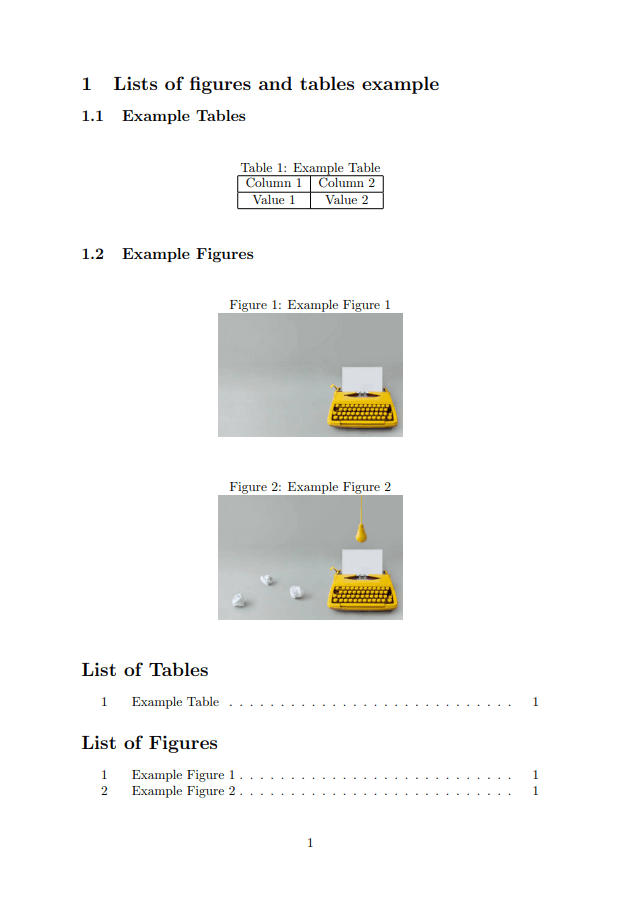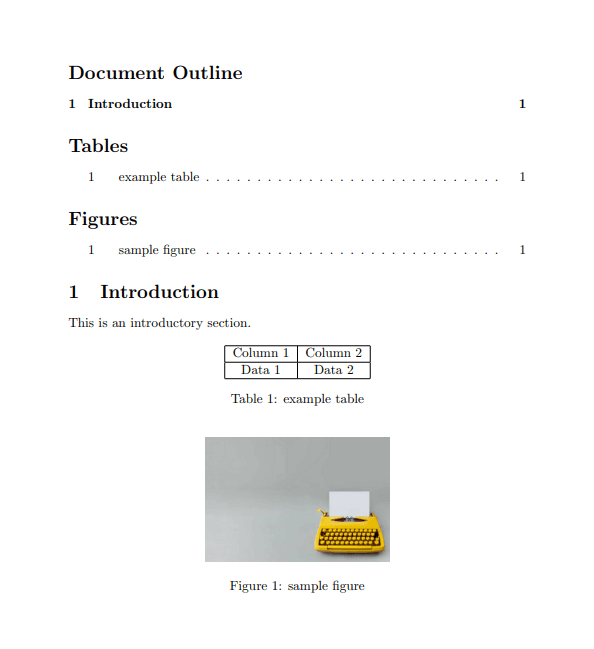Table of Contents
Discover the Table of Contents (ToC) - your document's roadmap! This crucial element provides a quick overview of the document's structure, enabling easy navigation through its sections and chapters.
Introduction
The Table of Contents (ToC) within documents serves as a navigational aid, outlining the structure and sequence of sections, chapters, and subsections. Its primary function is to provide readers with a clear roadmap of the document's content, enabling quick access to specific sections or topics.
This section, we'll explore creating and adjusting the Table of Contents (ToC). Additionally, we'll delve into Lists of Figures (LoF) and Tables (LoT), discussing their creation and customization.
Generating and customizing the Table of Contents
Creating a Table of Contents (ToC) in LaTeX involves a few steps:
-
Organize document structure
Ensure your document contains hierarchical elements like sections, subsections, etc., with appropriate commands such as\section,\subsection, etc. -
Generate ToC
Place the\tableofcontentscommand in your document where you want the ToC to appear (typically after the title or abstract). -
Compile twice
Compile your LaTeX document twice for the ToC to display correctly.
Here's an example:
\documentclass{article}
\begin{document}
\tableofcontents
\section{Introduction}
\subsection{Background}
\subsection{Purpose}
\section{Methods}
\subsection{Research Design}
\subsection{Data Collection}
\section{Results}
\subsection{Findings}
\subsection{Analysis}
\section{Conclusion}
\subsection{Summary}
\subsection{Recommendations}
\end{document}
This example will create the following table of contents:

You can use the tocloft package to customize the appearance and format of your table of contents, lists of figures, and tables in LaTeX documents.
To include the tocloft package and utilizing its features, add \usepackage{tocloft} to the preamble of your document.
Lists of figures and tables
Creating a list of figures and tables in LaTeX is essential for organizing information and facilitating easy navigation within a document. These lists provide readers with quick access to specific elements, enhancing the document's readability and usability. To generate lists of tables and figures, follow these steps:
1. Use the \caption command
Ensure that your tables and figures have captions. Use the \caption command to add captions to each table and figure in your document.
2. Generate LoF and LoT
In LaTeX, you can generate Lists of Figures (LoF) and Tables (LoT) using the following commands:
-
listoftables: This command generates a list of tables in your document. It automatically compiles a list that includes the captions and corresponding page numbers of all the tables you have defined in your document. -
listoffigures: This command is used to enable the list of figures. It automatically compiles a list that includes the captions and corresponding page numbers of all the figures you have defined in your document.
Place these commands in your LaTeX document where you want the lists to appear, such as at the beginning or in a dedicated section.
3. Compile the document twice
After adding or modifying tables and figures, compile the LaTeX document twice to update the list of tables and figures.
Here's an example:
\documentclass{article}
\usepackage{graphicx}
\begin{document}
% Your content with tables and figures
\section{Lists of figures and tables example}
\subsection{Example Tables}
\begin{table}[htbp]
\centering
\caption{Example Table}
\begin{tabular}{|c|c|}
\hline
Column 1 & Column 2 \\
\hline
Value 1 & Value 2 \\
\hline
\end{tabular}
\end{table}
\subsection{Example Figures}
\begin{figure}[htbp]
\centering
\caption{Example Figure 1}
\includegraphics[width=0.4\textwidth]{image1.png}
\end{figure}
\begin{figure}[htbp]
\centering
\caption{Example Figure 2}
\includegraphics[width=0.4\textwidth]{image2.png}
\end{figure}
% List of Tables and Figures
\listoftables
\listoffigures
\end{document}
This example generates the following output:

Changing the title of the lists
To change the default titles of the table of contents and lists of tables and figures in LaTeX, you can use the \renewcommand command. Here's how you can customize the titles:
- Changing the title of the ToC
\renewcommand{\contentsname}{<New Title>}
- Changing the title of the list of tables:
\renewcommand{\listtablename}{<New Title>}
- Changing the title of the list of figures:
\renewcommand{\listfigurename}{<New Title>}
Replace <New Title> with your desired titles.
Place these \renewcommand commands in the preamble of your LaTeX document, before the \begin{document} command. This ensures that the changes are applied throughout the document.
After making these changes, when you generate the ToC, list of tables or list of figures using the \tableofcontents, \listoftables or \listoffigures commands, the new titles you specified will be displayed. For example:
\documentclass{article}
\usepackage{graphicx}
% Change the titles of the lists
\renewcommand{\contentsname}{Document Outline}
\renewcommand{\listtablename}{Tables}
\renewcommand{\listfigurename}{Figures}
\begin{document}
\tableofcontents % Generate the table of contents
\listoftables % Generate the list of tables
\listoffigures % Generate the list of figures
\section{Introduction}
This is an introductory section.
\begin{table}[htbp]
\centering
\begin{tabular}{|c|c|}
\hline
Column 1 & Column 2 \\
\hline
Data 1 & Data 2 \\
\hline
\end{tabular}
\caption{example table}
\end{table}
\begin{figure}[htbp]
\centering
\includegraphics[width=0.4\textwidth]{image1.png}
\caption{sample figure}
\end{figure}
\end{document}
This example generates the following output:

Best practices and tips
Removing page numbers and headers/footers from list pages
In order to remove the page numbers and headers/footers from the pages where the lists are displayed, the following commands can be used:
\thispagestyle{empty}→ Used to remove the page numbering and header/footer content from a specific page.\pagenumbering{arabic}→ Starting the page numbering from the current page using Arabic numerals (1, 2, 3, ...).
Here's an example demonstrating the usage of these commands which often used when transitioning from front matter (e.g., title page, table of contents) to the main body of the document.
\documentclass{article}
\begin{document}
% Remove page numbers and headers/footers from the list of tables and figures page
\thispagestyle{empty}
\listoftables
\listoffigures
% Resume page numbering and switch to Arabic numerals
\pagenumbering{arabic}
% Rest of the document
\end{document}
This ensures that the lists of tables and figures do not have any numbering or additional elements that might distract from the content of the lists themselves.